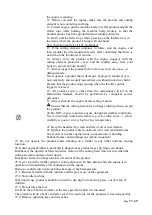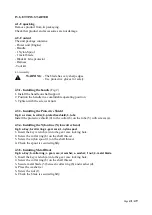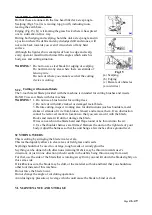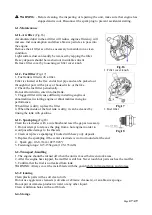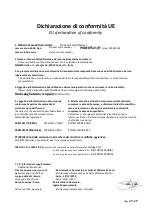
WARNING
- Pay attention to agitation.
1. Measure out the quantities of gasoline and oil to be mixed.
Only mix the amount of fuel you need for the job you intend to do.
2. Put some of the gasoline into a clean, approved fuel container.
3. Pour in all of the oil and agitate well.
4. Pour in the rest of gasoline and agitate again for at least one minute.
As some oils may be difficult to agitate depending on oil ingredients, sufficient agitation is
necessary for the engine to last long. Be careful that, if the agitation is insufficient, there is an
increased danger of early piston seizing due to abnormally lean mixture.
5. Store fuel in a clean, approved container according to local regulations.
6. Put a clear indication on the outside of the container to avoid mixing up with gasoline or other
containers.
7. Indicate the contents on outside of container for easy identification
4.4.3- Fueling the unit
Note: Ensure that cap and its surroundings are clean. If not, clean as necessary.
1. Untwist and remove the fuel cap.
Rest the cap on a dustless place.
2. Put fuel into the fuel tank to 80% of the full capacity.
Never fill in tank to its full capacity.
3. Fasten the fuel cap securely and wipe up any fuel spillage around the unit.
WARNING!
1. Never refuel with running engine or with a hot engine. Stop the engine and let it cool down
before refueling the unit. At that time, be sure to sufficiently agitate the mixed gasoline in the tank.
2. Select a bare and open ground for fueling, outdoors or well ventilated. Never add fuel to the tank
in a closed non-ventilated area.
3. Move at least 10 feet (3 meters) away from the fueling point before starting the engine.
4.4.4- To preserve your engine life:
1. Do not use raw gasoline (i.e. fuel with no oil); Gasohol; ethanol or methanol gasoline; Oil for 4-
cycle engine use;
2. Do not use mixed fuels which have been left unused for a period of one month or more may clog
the carburetor and result in the engine failing to operate properly.
3. In the case of storing the product for a long period of time, empty the fuel tank. Next, activate the
engine and empty the carburetor of the composite fuel.
4. In case of scrapping the used mixed oil & its container, scrap it only at an authorized repository site.
4.5- Engine
WARNING
It is very dangerous to run this product that mounts broken or loosen parts or lacking any parts.
Before starting engine, make sure that
all
the parts are installed properly.
4.5.1- Starting the engine
1. Fill fuel tank, and tighten the cap securely.
2. Continuously push the priming bulb until fuel comes in the bulb (Fig.7)
3. Set the switch to “START” (I) position. (Fig.8a)
4. Starting a cold engine: set the choke lever to close position (Fig.9).
5. Pull recoil starter handle (Fig.10) until engine fires.
6. Push choke lever down (Fig.9) (Note: excessive cranking with choke lever will cause flooding
engine making it difficult to start).
7. Allow engine to warm up for a few minutes before using.
Page
43
/
49
25
25









